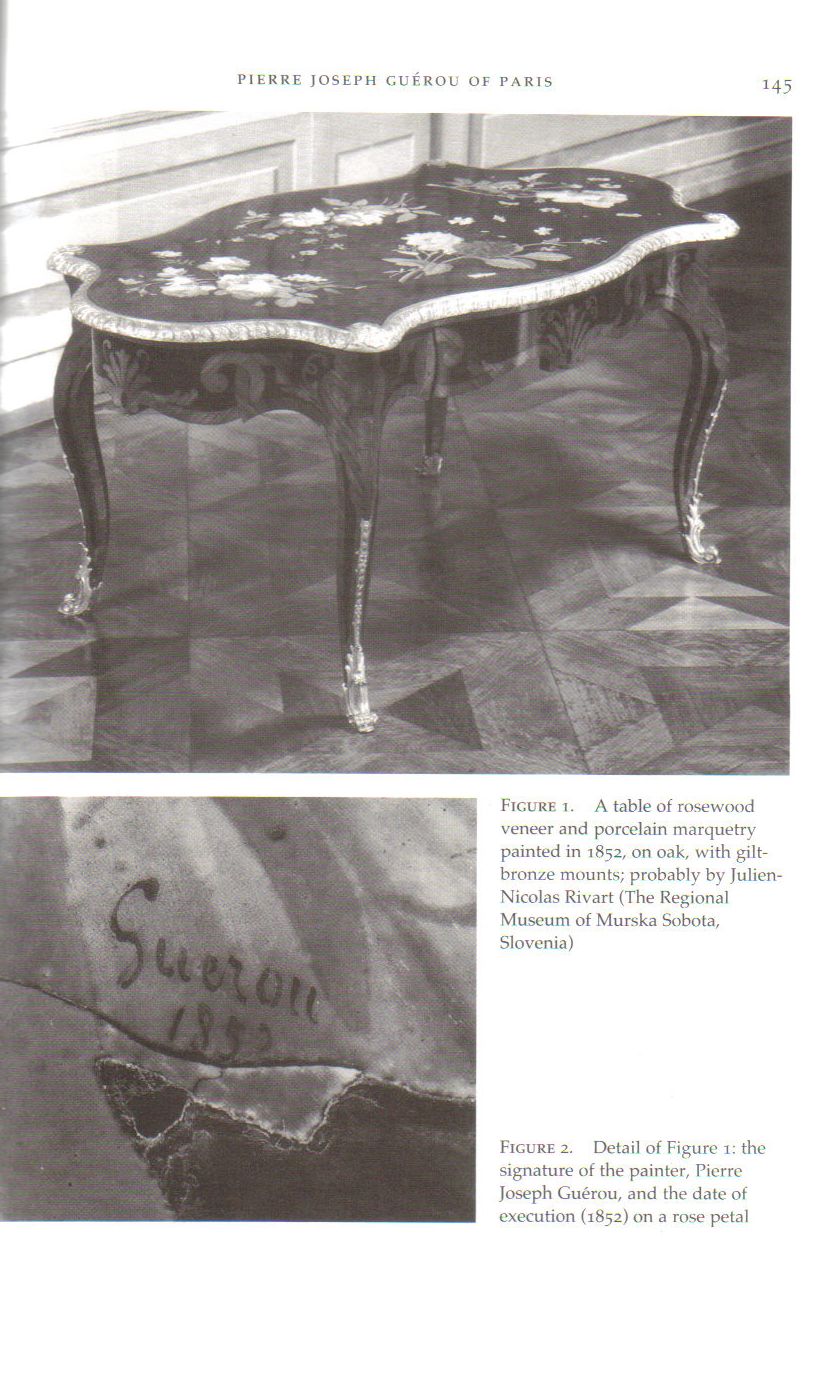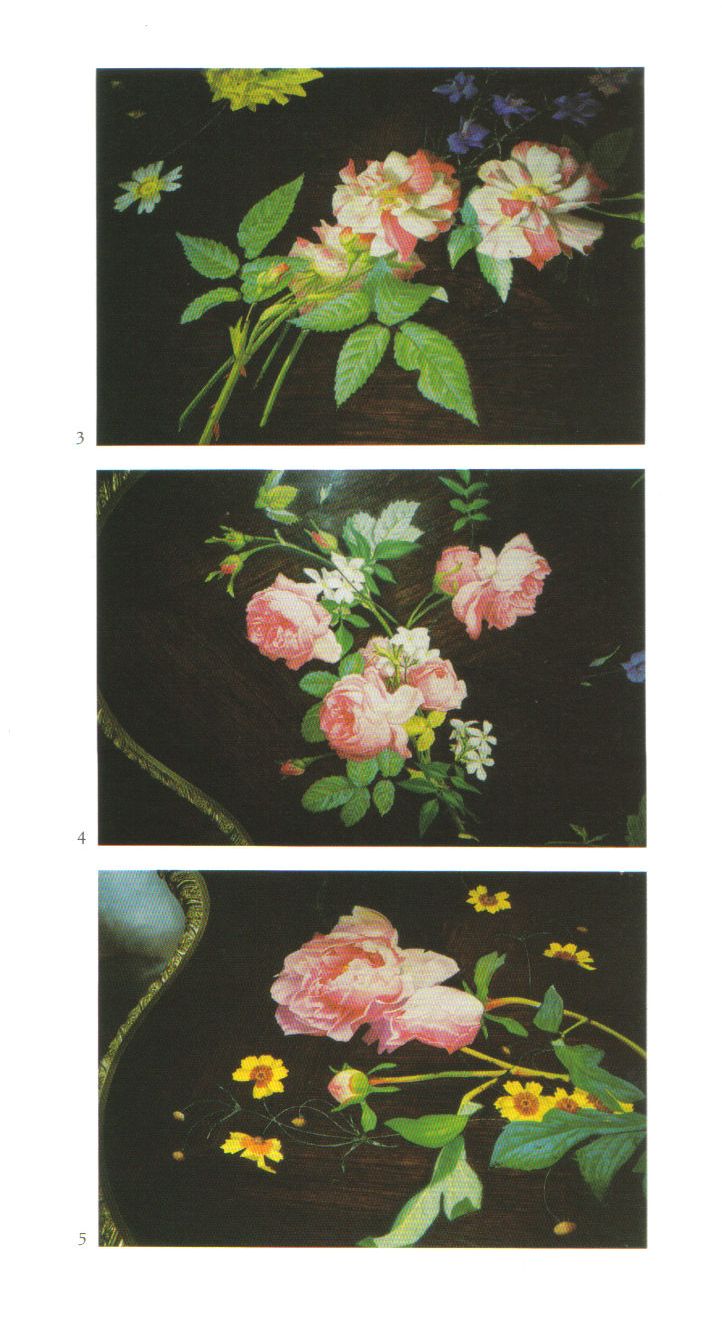An Ormolu-Mounted Mahogany and Porcelain Marquetry Bureau-Plat
By Julien-Nicolas Rivart, 1856
The porcelain by Pierre Joseph Guérou, 1853
The lock plate engraved Execute en 1856 par Tahan, Ebeniste breuete de l'empereur, the wood stamped twice on the underside RIVART & ANDREIUX BREVETES, the porcelain signed Guérou 1853
The porcelain by Pierre Joseph Guérou, 1853
The lock plate engraved Execute en 1856 par Tahan, Ebeniste breuete de l'empereur, the wood stamped twice on the underside RIVART & ANDREIUX BREVETES, the porcelain signed Guérou 1853
31 in (78.7 cm) high, 62 in (157.5 cm) wide, 37 in (94 cm) deep
cf. Maja Lozar Štamcar, 'A Porcelain Marquetry Table Painted by Pierre Joseph Guérou of Paris',
Furniture History: The Journal of the Furniture History Society, 2002, vol.38, pp.144-149
cf. Maja Lozar Štamcar, 'A Porcelain Marquetry Table Painted by Pierre Joseph Guérou of Paris',
Furniture History: The Journal of the Furniture History Society, 2002, vol.38, pp.144-149
Julien-Nicolas Rivart established his business in 1835 in Paris where he was considered one of the most distinguished suppliers of luxurious furniture. He invented a technique of combining veneer and porcelain marquetry (marqueterie de porcelaine) for which he obtained a patent in 1848. He had mastered this technique by 1851 and at the Crystal Palace Exhibition was deservedly awarded 16 medals for this high art form. He also exhibited furniture and objects decorated in this way at the Great Exhibitions of 1855 (Paris) and 1862 (London).
Rivart used Sèvres porcelain to decorate his furniture, and Pierre Joseph Guérou, who painted the plaques on this piece, was a known flower painter for Sèvres. Guérou worked for the porcelain manufactory in 1847 and 1848, and displayed his painting skill at the Paris Salons between 1849 and 1865.
In 1852, Rivart moved with his partner Andrieux to rue de Normandie in Paris where the porcelain, dated 1853, would have been executed by Guérou. Tahan's name on the lock (dated 1856) may be explained by the fact that Rivart provided various ébenistes with panels of porcelain marquetry which were subsequently sold as 'Meubles Rivart'. Unfortunately this demanding technique of porcelain and veneer marquetry was entirely abandoned after Rivart's death in 1867.
The bureau-plat is of serpentine form, the top inset with a naturalistic flower garland including roses, morning glories, carnations, peonies, delphiniums, hyacinths, apple blossom, tulips, parrot tulips, lilies of the valley, anemones, geraniums, narcissus, asters, begonias and clematis. Beneath this is a single drawer applied with rocaille decoration, the sides and reverse similarly decorated, the angles headed by espagnolettes, the whole on cabriole legs tapering on scrolled sabots.
A table with similar porcelain marquetry is in the collection of the Musée National de la Céramique in Sèvres. A similar centre-table with porcelain marquetry, also signed by Guérou and dated 1852, is in the collection of the Regional Murska Sobota Museum in Slovenia. An unsigned secrétaire with similar porcelain marquetry has been in the Palazzo Pitti in Florence since 1868. A table with ormolu-mounted rosewood, engraved copper and porcelain marquetry was exhibited in 1979 at the Grand Palais in Paris in an exhibition entitled 'L'Art sous le Second Empire'.
Rivart used Sèvres porcelain to decorate his furniture, and Pierre Joseph Guérou, who painted the plaques on this piece, was a known flower painter for Sèvres. Guérou worked for the porcelain manufactory in 1847 and 1848, and displayed his painting skill at the Paris Salons between 1849 and 1865.
In 1852, Rivart moved with his partner Andrieux to rue de Normandie in Paris where the porcelain, dated 1853, would have been executed by Guérou. Tahan's name on the lock (dated 1856) may be explained by the fact that Rivart provided various ébenistes with panels of porcelain marquetry which were subsequently sold as 'Meubles Rivart'. Unfortunately this demanding technique of porcelain and veneer marquetry was entirely abandoned after Rivart's death in 1867.
The bureau-plat is of serpentine form, the top inset with a naturalistic flower garland including roses, morning glories, carnations, peonies, delphiniums, hyacinths, apple blossom, tulips, parrot tulips, lilies of the valley, anemones, geraniums, narcissus, asters, begonias and clematis. Beneath this is a single drawer applied with rocaille decoration, the sides and reverse similarly decorated, the angles headed by espagnolettes, the whole on cabriole legs tapering on scrolled sabots.
A table with similar porcelain marquetry is in the collection of the Musée National de la Céramique in Sèvres. A similar centre-table with porcelain marquetry, also signed by Guérou and dated 1852, is in the collection of the Regional Murska Sobota Museum in Slovenia. An unsigned secrétaire with similar porcelain marquetry has been in the Palazzo Pitti in Florence since 1868. A table with ormolu-mounted rosewood, engraved copper and porcelain marquetry was exhibited in 1979 at the Grand Palais in Paris in an exhibition entitled 'L'Art sous le Second Empire'.


















